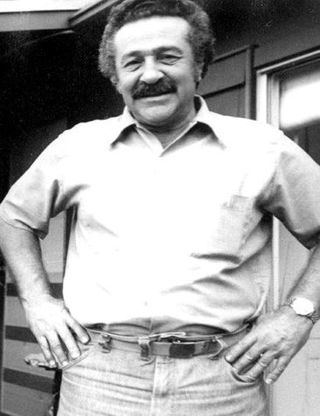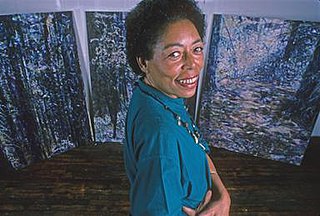Lowery Stokes Sims is an American art historian and curator of modern and contemporary art known for her expertise in the work of African, African American, Latinx, Native and Asian American artists such as Wifredo Lam, Fritz Scholder, Romare Bearden, Joyce J. Scott and others. She served on the curatorial staff of the Metropolitan Museum of Art, the Studio Museum in Harlem, and the Museum of Arts and Design. She has frequently served as a guest curator, lectured internationally and published extensively, and has received many public appointments. Sims was featured in the 2010 documentary film !Women Art Revolution.
Amelia Jones, originally from Durham, North Carolina, is an American art historian, art theorist, art critic, author, professor and curator. Her research specialisms include feminist art, body art, performance art, video art, identity politics, and New York Dada. Jones's earliest work established her as a feminist scholar and curator, including through a pioneering exhibition and publication concerning the art of Judy Chicago; later, she broadened her focus on other social activist topics including race, class and identity politics. Jones has contributed significantly to the study of art and performance as a teacher, researcher, and activist.
Alison Saar is a Los Angeles, California based sculptor, mixed-media, and installation artist. Her artwork focuses on the African diaspora and black female identity and is influenced by African, Caribbean, and Latin American folk art and spirituality. Saar is well known for "transforming found objects to reflect themes of cultural and social identity, history, and religion."

Nathan Oliveira was an American painter, printmaker, and sculptor, born in Oakland, California to immigrant Portuguese parents. Since the late 1950s, Oliveira has been the subject of nearly one hundred solo exhibitions, in addition to having been included in hundreds of group exhibitions in important museums and galleries worldwide. He taught studio art for several decades in California, beginning in the early 1950s, when he taught at the California College of Arts and Crafts in Oakland. After serving as a Visiting Artist at several universities, he became a Professor of Studio Art at Stanford University.
Svetlana Leontief Alpers is an American art historian, also a professor, writer and critic. Her specialty is Dutch Golden Age painting, a field she revolutionized with her 1984 book The Art of Describing. She has also written on Tiepolo, Rubens, Bruegel, and Velázquez, among others.
Nada M. Shabout is an American art historian specializing in modern Iraqi art. She has been a professor of art history at the University of North Texas since 2002. She is the president and co-founding board member of the Association for Modern and Contemporary Art (AMCA) of the Arab World, Iran, and Turkey.

Natasha Boas is a French-American contemporary art curator, writer, and critic. She has taught art history and curatorial studies at Yale, Stanford, and the San Francisco Art Institute. Her exhibition on the Modernist Algerian artist, Baya Mahieddine Baya: Woman of Algiers in 2018 at the Grey Art Gallery at New York University garnered her international critical attention. In 2017 she was featured in Lynn Hershman Leeson's Vertighost, playing the role of herself as an art historian. She also authored the Facebook Artist in Residence book on the recent history of Art and Technology in the Bay Area for the 5th anniversary of Facebook's artist-in-residency program. An adjunct professor at the California College of the Arts, she is an expert in the art of California countercultures, the modernist avant-garde, surrealist women artists, the Mission School and Outsider artists.

Wanda Ewing (1970–2013) was an artist born in Omaha, Nebraska. She considered her art to be "provocative with a political edge." A common message of her art was “I’m a proud black woman, and I’m going to be hard to ignore.” Ewing studied printmaking at San Francisco Art Institute where she received her BFA in 1997. She received her MA and MFA in printmaking at the University of Iowa in 2001 and 2002, respectively. She was a tenured professor at the University of Nebraska at Omaha, where she taught visual arts classes from 2004 to 2013. Ewing exhibited nationally and won several awards for her work.
Sidra Stich is an American art historian, museum curator, and travel writer based in San Francisco.

Vivian E. Browne was an American artist. Born in Laurel, Florida, Browne was mostly known for her African-American protest paintings, and linking abstraction to nature. She has received multiple awards for her work, been an activist, professor and a founder of many galleries. According to her mother, Browne died at 64 from bladder cancer.
Jolene Rickard, born 1956, citizen of the Tuscarora nation, Turtle clan, is an artist, curator and visual historian at Cornell University, specializing in indigenous peoples issues. Rickard co-curated two of the four permanent exhibitions for the Smithsonian’s National Museum of the American Indian.
Eleanor May Tufts was an American art historian, feminist and professor of art history at Southern Methodist University in Dallas, Texas.
Taravat Talepasand is an Iranian-American contemporary artist, activist, and educator. She is known for her interdisciplinary painting practice including drawing, sculpture and installation. As an Iranian-American woman, Talepasand explores the cultural taboos that reflect on gender and political authority. Her approach to representation and figuration reflects the cross-pollination, or lack thereof, in our Western Society. Talepasand previously held the title of the chair of the painting department at San Francisco Art Institute (SFAI). She is a Tenure-Track professor in Art Practice at Portland State University, College of Art + Design.

Suzanne Jackson is an American visual artist, gallery owner, poet, dancer, educator, and set designer; with a career spanning five decades. Her work has been exhibited in museums and galleries around the world. Since the late 1960s, Jackson has dedicated her life to studio art with additional participation in theatre, teaching, arts administration, community life, and social activism. Jackson's oeuvre includes poetry, dance, theater, costume design, paintings, prints, and drawings.
David M. Lubin is an American writer, professor, curator, and scholar. He has published six books on American art, film, and popular culture.

Harry W. Anderson, also known as Hunk Anderson, was an American businessman, art collector and philanthropist. He was the co-founder of Saga Foods Co., a food company for college dormitories. With his wife, Mary Margaret Anderson, he donated works of art to the San Francisco Museum of Modern Art and to the Iris & B. Gerald Cantor Center for Visual Arts at Stanford University.

Margaret Rose Vendryes was a visual artist, curator, and art historian based in New York.

Andrea Graciela Giunta is an Argentine art historian, professor, researcher, and curator.
Nancy Genn is an American artist living and working in Berkeley, California known for works in a variety of media, including paintings, bronze sculpture, printmaking, and handmade paper rooted in the Japanese washi paper making tradition. Her work explores geometric abstraction, non-objective form, and calligraphic mark making, and features light, landscape, water, and architecture motifs. She is influenced by her extensive travels, and Asian craft, aesthetics and spiritual traditions.
Erika Lee Doss is an American educator and author, having served as a professor in the Department of American Studies at the University of Notre Dame.








